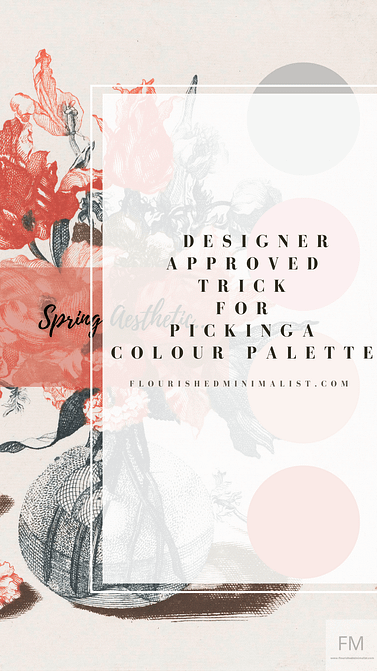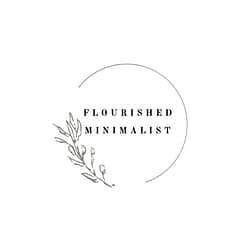When it comes to decorating a small apartment, choosing the right color palette is key. Color can completely transform a space, making it feel larger, cozier, or more stylish. But with limited space, it can be challenging to know which colors to choose. In this blog post, I’ll share some tips on picking the right color palette for a small apartment.

1. Stick to light colors
The first and most important rule for decorating a small space is to stick to light colors. Light colors reflect more natural light, making a room feel brighter and more spacious. On the other hand, dark colors absorb light, making a room feel smaller and more enclosed.
When selecting a color scheme for your small apartment, consider using light colors like white, cream, beige, and pastels. These colors will help create a bright, airy feel, making your space feel more open and inviting.

Ballerina water colour painting: By Boyana Petkova @ artfinder.com
LOB Coffee table: monologuelondon.com
Amira Moroccan Dusk Rug: therugcollective.com
2. Use monochromatic colors
Another effective way to create a cohesive and calming atmosphere in a small apartment is to use monochromatic colors. This means using different shades of the same color throughout your space.
For example, if you choose blue as your primary color, you can use light blue on your walls, navy blue on your sofa, and teal blue on your pillows and accessories. This creates a seamless look that makes your space feel more expansive.
Using monochromatic colors also allows you to experiment with textures and patterns without overwhelming the eye.
3. Incorporate pops of bold colors
While it’s important to stick to light and monochromatic colors in a small apartment, that doesn’t mean you can’t add pops of bold colors to create interest and personality.
For example, you can add a brightly colored accent wall to create depth and visual interest. Or, you can add a bold rug or throw pillows in a bright hue to add energy and excitement to your space.
When incorporating bold colors, it’s important to use them sparingly so as not to overwhelm the eye or make your space feel cluttered. A few well-placed pops of color can go a long way in adding interest to your small apartment.
4. Consider using a single accent wall
If you’re looking to add more color to your small apartment but don’t want to overwhelm the space, consider using a single accent wall. An accent wall is a wall that is painted or covered in a different material than the other walls in a room. This creates a focal point that draws the eye and adds visual interest.
For example, you can paint one wall in a bold color to create a statement wall. This draws the eye and makes the room feel more dynamic, without overwhelming the space with too much color.
When selecting an accent wall color, it’s important to consider the other colors in your space. Choose a color that complements your existing color scheme, rather than clashing with it.
5. Use mirrors strategically
Mirrors are an essential tool for decorating a small apartment. Not only do they reflect light and create the illusion of more space, but they also add style and interest to your walls.
When using mirrors in a small apartment, it’s important to use them strategically. For example, you can place a large mirror opposite a window to reflect natural light and make the room feel brighter and more open.
You can also use a series of small mirrors to create a gallery wall that adds visual interest and depth to your space.
6. Consider the psychology of color
When selecting a color palette for your small apartment, it’s important to consider the psychology of color. Different colors can have a powerful effect on our moods and emotions, so it’s important to choose colors that make you feel happy and comfortable.
For example, blue is a calming and soothing color that is perfect for bedrooms and bathrooms. Green is a restorative color that is ideal for creating a cozy living room.
Consider the mood you are trying to achieve in a room and pick a color that reflects it.

7. Use cool colors like blue and green to create a calming and restorative atmosphere.
Cool colors like blue and green are excellent choices for bedrooms and bathrooms because they have a calming and restorative effect on our minds and bodies.
Blue is known to be a calming color that can help lower blood pressure and heart rate, making it an excellent choice for creating a relaxing and tranquil bedroom environment. Soft shades of blue, like sky blue or powder blue, can evoke a sense of serenity and calmness, making them perfect for creating a restful atmosphere.
Green, on the other hand, is a restorative color that can help reduce stress and anxiety. Green is often associated with nature, which can have a soothing and rejuvenating effect on our minds and bodies. Using shades of green in your bathroom can create a spa-like atmosphere that feels calming and rejuvenating.

8. Use warm colors like red and orange in living spaces to add energy and excitement.
Warm colors like red and orange are excellent choices for living spaces because they can add energy and excitement to your home. These colors are known for their ability to stimulate the senses, increase appetite, and create a sense of warmth and coziness.
Using shades of red and orange in your living room can create a welcoming and inviting atmosphere that feels lively and energetic. When choosing these colors, it’s important to consider the shade and tone to ensure they complement your existing decor and create a balanced look. Pairing warm colors with neutral tones or cooler accent colors, like blues or greens, can help create a sense of balance and harmony in your space, making it feel both lively and inviting.
9. Don’t be afraid to experiment with patterns and textures, but stick to a consistent color scheme to create a cohesive look.
Using patterns and textures is an excellent way to add interest and depth to your small apartment, but it’s important to do so with a consistent color scheme in mind. Mixing too many colors can make your space feel cluttered and chaotic while sticking to a consistent color palette can create a cohesive and polished look. When experimenting with patterns and textures, it’s helpful to start with a neutral base, such as a solid-colored sofa or rug.
From there, you can add in accent pillows, curtains, or artwork with different patterns and textures that complement your color scheme. Mixing and matching different patterns, such as stripes, florals, or geometric shapes, can add visual interest to your space, but it’s important to keep a consistent color theme throughout. By doing so, you can create a space that feels dynamic and visually engaging, while still maintaining a cohesive and polished look.
10. Test your color choices in natural light to ensure they look the way you want them to in your space.
Testing your color choices in natural light is an essential step to ensure your colors look the way you want them to in your small apartment. Natural light can greatly affect the way colors appear, and artificial lighting can distort the way colors are perceived. To test your colors, it’s helpful to paint small swatches on your walls or hold up fabric samples in natural light to see how they look. Make sure to test the colors at different times of the day to see how they look in different lighting conditions.
It’s also important to consider the direction of your windows and the amount of natural light that enters your space. South-facing rooms tend to get more light and can handle darker colors, while north-facing rooms may require lighter and warmer tones to make them feel brighter and more inviting. By testing your colors in natural light, you can avoid costly mistakes and ensure that your small apartment looks the way you want it to.
Transform Your Small Apartment with the Perfect Color Palette: Book Your Personalized 1:1 Color Consultation Today!
In conclusion, selecting the right color palette is an essential step in creating a beautiful and functional small apartment. Whether you’re looking to add warmth and energy with warm colors or create a calming oasis with cool tones, understanding the basics of color theory and testing your choices in natural light can help you achieve your desired result.
However, if you’re feeling overwhelmed or unsure of where to start, my 1:1 color consultation coaching service can help. We will work together to identify your specific needs and preferences -So as to create a personalized color palette that is tailored to your unique space. While free information is valuable, investing in a personalized service can provide you with the guidance and expertise you need to create a space that truly reflects your personality and style.
Book a free 30-minute home audit call where we will discuss a plan to create the Perfect Color Palette your home. ( yes for real- the first 3o minutes are free)
with love
-Dolorese
